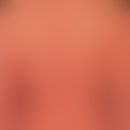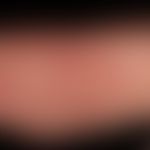DefinitionThis section has been translated automatically.
Skin damage due to contact with chemical noxae, e.g. acids or alkalis. Acids cause coagulation necrosis, hard scabs appear macroscopically. Alkalis lead to colliquation necrosis, macroscopically the greasy dissolution of the skin, see also bird's eye.
Clinical featuresThis section has been translated automatically.
- Superficial burns are characterised by extensive red spots limited to the contamination site and its surroundings, and possibly also by erosion.
- In the case of more extensive damage, blurred erosions or ulcerations on red, inflammationally altered surroundings are impressive. The erosions or ulcerations can be crust-covered ("etching scab") or necrotically altered. Acid-etched scabs are parchment-like, sharply delimited, with little accompanying inflammation and an inflammatory infiltrate. Lesions caused by alkalis or alkaline solutions show a softer scab, are blurred and are more often accompanied by marginal oedema and discoloration (different hemoglobinaba levels). In some cases there are traces of abrasions. Frequently, burns tend to cause secondary infections and scarred healings. The scars are prone to hypertrophy or keloid-like growths, ulcerations and, more rarely, malignant degeneration.
External therapyThis section has been translated automatically.
Removal of the pollutant, rinsing with plenty of running water for 20-30 minutes, followed by wound treatment as for burns. In case of hydrofluoric acid burns, see below. Hydrofluoric acid burns. Later excision, otherwise glucocorticoid-containing ointments, heparin or heparinoid-containing ointments for keloid prophylaxis.
Internal therapyThis section has been translated automatically.
Glucocorticoids such as prednisolone (e.g. Solu Decortin H) 50-250 mg/day with gradual dose reduction depending on the extent and degree of the burn. In case of superinfection, antibiosis after antibiogram if necessary (repeated smears in the course of the treatment).
Incoming links (7)
Bird's eye; Cauterization; Coagulation necrosis; Colliquative necrosis; Eyewash; Hydrofluoric acid etching; Wound treatment;Outgoing links (11)
Bird's eye; Coagulation necrosis; Colliquative necrosis; Excision; Glucocorticosteroids; Heparin; Heparinoids, topical; Hydrofluoric acid etching; Incineration; Keloid (overview); ... Show allDisclaimer
Please ask your physician for a reliable diagnosis. This website is only meant as a reference.







